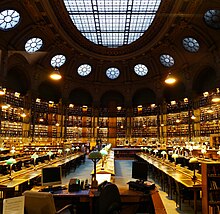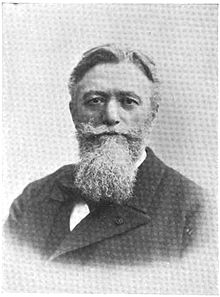Jean-Louis Pascal
Jean-Louis Pascal (born June 4, 1837 in Paris ; died May 17, 1920 there ) was a French architect of the Beaux Arts tradition .
life and work

Pascal was admitted to the Paris École des Beaux Arts in 1855 and completed his studies there, he was a student of Émile-Jacques Gilbert (1793–1874) and Charles-Auguste Questel (1807–1888).
In his fifth attempt, he won the Prix de Rome for architecture in 1866 , having finished second in 1859 and 1864. In parallel to his applications for the prestigious award, he acted as one of the Tuileries site managers and assisted Charles Garnier in the construction of the Paris Opéra . For the painter William-Adolphe Bouguereau (1825-1905), the master of academic classicism , he designed his studio and living quarters at 75 Rue Notre-Dame-des-Champs. From the beginning of 1867 to the end of 1870 he lived - due to the award and of the scholarship - at the Villa Medici in Rome , studied the Palatine Hill and the excavations of Pompeii .
After brief service in the Franco-Prussian War , he returned to Paris, where he assisted Hector Lefuel in the overhaul of the Louvre . He took part in the competition for the Sacré-Cœur de Montmartre and won the competition for the reconstruction of the Hôtel de Ville in Paris . When Henri Labrouste , the architect of the renovations and extensions to the Bibliothèque Nationale , died in 1875, Pascal was entrusted with the continuation of this honorable task. The architect then worked on this complex structure until the end of his life. He designed the interiors and exteriors, the famous Salle Ovale, the Salon Voltaire, the magazine room and the staircase. In 1875 Pascal was also appointed diocesan architect of the diocese of Valence , and in 1988 he assumed the same function in the archbishopric of Avignon .
Pascal designed a number of memorials and monuments throughout France, including in 1893, together with the sculptor Antonin Mercié, the tomb for Jules Michelet in the Père-Lachaise cemetery and in 1902 the monument to Victor Hugo on the Place Victor-Hugo in Paris with bronze sculptures by Louis- Ernest Barrias (1841-1905). This monument was demolished during the Nazi occupation of France in 1942; a fountain has stood here since 1964 .
The architect received several awards, as early as 1866 at the Salon de Paris , where he won a medal. He also received a first class medal on the occasion of the World Exhibition in Paris in 1878 . Two years later he was appointed Chevalier de la Légion d'honneur , officier in 1889 and finally in 1903 commander of the Legion of Honor. From 1878 he worked on the jury of the École des Beaux Arts , to whose professor he was finally appointed. In 1888 he took over the studio of his former teacher Questel. Pascal was also appointed to the jury of the Paris World Exhibition in 1900 . In 1914 he received the highest award of his British and American colleagues, their gold medal . His studio has also received several awards.


Other buildings (selection)
- 1869–1873 Reconstruction of the Château d'Escurès in Commes, Calvados
- 1876–1888, and 1902–1922 Faculty of Medicine and Pharmacy at the University of Victor Segalen Bordeaux II , Bordeaux
- 1883 Mairie and school in Ablon-sur-Seine , Val-de-Marne
- 1883–1884 Palais Königswarter at 12 Rue de Prony in the 17th arrondissement of Paris
- 1908 Château du Doux in Altillac , Corrèze
influence
Pascal made a significant impact as a teacher - both from young French architects and from a number of international students who learned French-style historicism from him and then spread it worldwide. Among his most important students were
- the Swiss Adrien Peyrot (1856–1918), later an architect in Geneva ,
- the French Constant-Désiré Despradelle (1862–1912), who then worked for a whole generation of architects at MIT in Cambridge, Mass. should train
- the French Henri Sauvage (1873-1932), whose buildings reflect the development from Art Nouveau to Art Deco , and
- Canadian William Sutherland Maxwell (1874-1952), designer of the Shrine of the Bab the city of Haifa .
Other important students were the Scot Sir John James Burnet (builder of the Charing Cross Mansions in Glasgow ), the Canadian Ernest Cormier, the French Paul Philippe Cret (more than thirty years a teacher at the University of Pennsylvania ), the American Guy Lowell ( Architect of the Boston Museum of Fine Arts ), the French Charles Mewès (builder of the three Ritz Hotels in Paris, London and Madrid) and Henri-Paul Nénot (architect of the Palais des Nations in Geneva), as well as the Englishman Richard Spiers .
However , Pascal did not recognize talents like Tony Garnier .
Significant awards
- 1866 Prix de Rome
- 1866 Ordre des Palmes Académiques not guaranteed
- 1890 admission to the Académie des Beaux-Arts
- 1903 Commander of the Legion of Honor
- 1914 gold medal from the American Institute of Architects
- 1914 Royal Gold Medal from the Royal Institute of British Architects
literature
- Jean-Louis Pascal: Dîner des Prix de Rome. Lettre de Jean-Louis Pascal. Paris, November 16, 1913.
- Roberto Cassanelli, Massimiliano David: Ruins of Ancient Rome: The Drawings of French Architects who Won the Prix de Rome, 1786–1924. Getty Publications, 2002, ISBN 0-89236-680-X .
- Cecil D. Elliott: The American architect from the colonial era to the present. Mcfarland & Co Pub, 2002, ISBN 0-7864-1391-3 .
- Anne Richard Bazire: Le concours pour la reconstruction de l'Hôtel de Ville de Paris (1872–1873), un échec pour l'architecte Jean-Louis Pascal. In: Livraisons d'histoire de l'architecture, 2010, 1st semestre, no.19, Paris 2001.
Web links
- Sorbonne , short biography of the architect (French)
Individual evidence
- ^ République française , Inventaire général du Patrimoine culturel de Basse-Normandie, accessed on May 8, 2014.
- ↑ République française , REQUETÉ Pascal, Jean-Louis, accessed on May 8, 2014.
- ^ The World Organization for Animal Health and its headquarters , accessed May 8, 2014.
| personal data | |
|---|---|
| SURNAME | Pascal, Jean-Louis |
| BRIEF DESCRIPTION | French architect of the Beaux Arts tradition |
| DATE OF BIRTH | June 4, 1837 |
| PLACE OF BIRTH | Paris |
| DATE OF DEATH | May 17, 1920 |
| Place of death | Paris |
